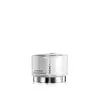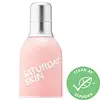What's inside
What's inside
 Key Ingredients
Key Ingredients

 Benefits
Benefits

 Concerns
Concerns

 Ingredients Side-by-side
Ingredients Side-by-side

Phyllostachys Bambusoides Juice
Skin ConditioningCyclopentasiloxane
EmollientDimethicone
EmollientGlycerin
HumectantButylene Glycol
HumectantCyclohexasiloxane
EmollientAlcohol
AntimicrobialWater
Skin ConditioningPEG-75
HumectantPEG-10 Dimethicone
Skin ConditioningBiosaccharide Gum-1
HumectantSqualane
EmollientNiacinamide
SmoothingAcetyl Glucosamine
Skin ConditioningHydrolyzed Phyllostachys Bambusoides
HumectantHydrolyzed Camellia Sinensis Leaf
HumectantGlycine Soja Seed Extract
Skin ConditioningNelumbo Nucifera Flower Extract
Skin ConditioningOpuntia Coccinellifera Fruit Extract
Skin ConditioningHesperidin
EmollientCaffeine
Skin ConditioningTheanine
EmollientKaempferol
AntioxidantCamellia Sinensis Flower Extract
PerfumingNatto Gum
Beta-Glucan
Skin ConditioningSodium Hyaluronate
HumectantTocopherol
AntioxidantPhytantriol
HumectantEpigallocatechin Gallate
AntioxidantDisteardimonium Hectorite
StabilisingLauryl PEG-9 Polydimethylsiloxyethyl Dimethicone
Skin ConditioningPolysilicone-11
Propanediol
SolventDimethiconol
EmollientDimethicone/Vinyl Dimethicone Crosspolymer
Skin ConditioningStearyl Behenate
EmollientPolyglyceryl-3 Methylglucose Distearate
EmulsifyingHydroxypropyl Bispalmitamide Mea
EmollientInulin Lauryl Carbamate
Emulsion StabilisingPolysorbate 20
EmulsifyingPEG-15 Pentaerythrityl Tetra(Laureth-6 Carboxylate)
HumectantSodium Chloride
MaskingPoloxamer 407
EmulsifyingAmmonium Acryloyldimethyltaurate/Vp Copolymer
1,2-Hexanediol
Skin ConditioningDisodium EDTA
Ethylhexylglycerin
Skin ConditioningPhenoxyethanol
PreservativeParfum
MaskingPhyllostachys Bambusoides Juice, Cyclopentasiloxane, Dimethicone, Glycerin, Butylene Glycol, Cyclohexasiloxane, Alcohol, Water, PEG-75, PEG-10 Dimethicone, Biosaccharide Gum-1, Squalane, Niacinamide, Acetyl Glucosamine, Hydrolyzed Phyllostachys Bambusoides, Hydrolyzed Camellia Sinensis Leaf, Glycine Soja Seed Extract, Nelumbo Nucifera Flower Extract, Opuntia Coccinellifera Fruit Extract, Hesperidin, Caffeine, Theanine, Kaempferol, Camellia Sinensis Flower Extract, Natto Gum, Beta-Glucan, Sodium Hyaluronate, Tocopherol, Phytantriol, Epigallocatechin Gallate, Disteardimonium Hectorite, Lauryl PEG-9 Polydimethylsiloxyethyl Dimethicone, Polysilicone-11, Propanediol, Dimethiconol, Dimethicone/Vinyl Dimethicone Crosspolymer, Stearyl Behenate, Polyglyceryl-3 Methylglucose Distearate, Hydroxypropyl Bispalmitamide Mea, Inulin Lauryl Carbamate, Polysorbate 20, PEG-15 Pentaerythrityl Tetra(Laureth-6 Carboxylate), Sodium Chloride, Poloxamer 407, Ammonium Acryloyldimethyltaurate/Vp Copolymer, 1,2-Hexanediol, Disodium EDTA, Ethylhexylglycerin, Phenoxyethanol, Parfum
Water
Skin ConditioningGlycerin
HumectantButylene Glycol
HumectantCyclopentasiloxane
EmollientTrehalose
HumectantPentylene Glycol
Skin ConditioningPolyglycerin-3
HumectantPyrus Malus Seed Oil
Emollient1,2-Hexanediol
Skin ConditioningPyrus Malus Fruit Water
MaskingCitrus Limon Peel Oil
MaskingJuniperus Mexicana Oil
MaskingCitrus Aurantium Dulcis Peel Oil
MaskingCitrus Grandis Peel Oil
MaskingEucalyptus Globulus Leaf Oil
PerfumingLavandula Angustifolia Oil
MaskingRosmarinus Officinalis Leaf Oil
MaskingPhoenix Dactylifera Seed
Skin ConditioningHydrolyzed Avocado Protein
Skin ConditioningDipentaerythrityl Hexa C5-9 Acid Esters
Skin ConditioningCyclohexasiloxane
EmollientGlyceryl Stearate
EmollientHydroxyethyl Acrylate/Sodium Acryloyldimethyl Taurate Copolymer
Emulsion StabilisingPEG-100 Stearate
Dimethicone/Vinyl Dimethicone Crosspolymer
Skin ConditioningPropanediol
SolventAcrylates/C10-30 Alkyl Acrylate Crosspolymer
Emulsion StabilisingPEG-11 Methyl Ether Dimethicone
EmulsifyingTromethamine
BufferingPEG/PPG-19/19 Dimethicone
EmulsifyingHydrogenated Lecithin
EmulsifyingAscorbic Acid
AntioxidantCholesterol
EmollientPEG-800
HumectantPolysorbate 20
EmulsifyingMaltodextrin
AbsorbentSaccharide Hydrolysate
HumectantPolyglutamic Acid
Skin ConditioningSodium Hyaluronate
HumectantSh-Oligopeptide-1
Skin ConditioningSh-Polypeptide-1
Skin ConditioningSh-Oligopeptide-2
Skin ConditioningSh-Polypeptide-22
Skin ConditioningSh-Polypeptide-45
Skin ConditioningSh-Polypeptide-8
HumectantSh-Polypeptide-9
Skin ConditioningCetearyl Alcohol
EmollientXanthan Gum
EmulsifyingDisodium EDTA
Water, Glycerin, Butylene Glycol, Cyclopentasiloxane, Trehalose, Pentylene Glycol, Polyglycerin-3, Pyrus Malus Seed Oil, 1,2-Hexanediol, Pyrus Malus Fruit Water, Citrus Limon Peel Oil, Juniperus Mexicana Oil, Citrus Aurantium Dulcis Peel Oil, Citrus Grandis Peel Oil, Eucalyptus Globulus Leaf Oil, Lavandula Angustifolia Oil, Rosmarinus Officinalis Leaf Oil, Phoenix Dactylifera Seed, Hydrolyzed Avocado Protein, Dipentaerythrityl Hexa C5-9 Acid Esters, Cyclohexasiloxane, Glyceryl Stearate, Hydroxyethyl Acrylate/Sodium Acryloyldimethyl Taurate Copolymer, PEG-100 Stearate, Dimethicone/Vinyl Dimethicone Crosspolymer, Propanediol, Acrylates/C10-30 Alkyl Acrylate Crosspolymer, PEG-11 Methyl Ether Dimethicone, Tromethamine, PEG/PPG-19/19 Dimethicone, Hydrogenated Lecithin, Ascorbic Acid, Cholesterol, PEG-800, Polysorbate 20, Maltodextrin, Saccharide Hydrolysate, Polyglutamic Acid, Sodium Hyaluronate, Sh-Oligopeptide-1, Sh-Polypeptide-1, Sh-Oligopeptide-2, Sh-Polypeptide-22, Sh-Polypeptide-45, Sh-Polypeptide-8, Sh-Polypeptide-9, Cetearyl Alcohol, Xanthan Gum, Disodium EDTA
Ingredients Explained
These ingredients are found in both products.
Ingredients higher up in an ingredient list are typically present in a larger amount.
1,2-Hexanediol is a synthetic liquid and another multi-functional powerhouse.
It is a:
- Humectant, drawing moisture into the skin
- Emollient, helping to soften skin
- Solvent, dispersing and stabilizing formulas
- Preservative booster, enhancing the antimicrobial activity of other preservatives
Butylene Glycol (or BG) is used within cosmetic products for a few different reasons:
Overall, Butylene Glycol is a safe and well-rounded ingredient that works well with other ingredients.
Though this ingredient works well with most skin types, some people with sensitive skin may experience a reaction such as allergic rashes, closed comedones, or itchiness.
Learn more about Butylene GlycolCyclohexasiloxane is a type of silicone more commonly known as D6. It is an emollient and solvent.
Cyclohexasiloxane is used to evenly distribute ingredients throughout the product. When applied to the skin, Cyclohexasiloxane evaporates and leaves behind a silky feel.
As an emollient, it can help the skin feel soft and hydrated. It is also used to reduce frizz in hair products.
Learn more about CyclohexasiloxaneCyclopentasiloxane, or D5, is a silicone used to improve texture of products and trap moisture.
D5 is considered lightweight and volatile. Volatile means it evaporates quickly after application. Once evaporated, D5 leaves a thin barrier that helps keep skin hydrated.
It is also an emollient. Emollients help soften the skin and prevent water loss. Silicones create a silky texture in products. D5 helps other ingredients become more spreadable.
Studies show D5 is safe to use in skincare products. We recommend speaking with a skincare professional if you have concerns.
Learn more about CyclopentasiloxaneThis ingredient is a silicone used to improve the texture of products and absorb oil. It does not get absorbed into the skin.
Like other silicones, Dimethicone/Vinyl Dimethicone Crosspolymer helps condition the skin by creating a barrier. In this sense, it can act as an emollient and trap moisture in.
This ingredient is a type of elastomer.
Learn more about Dimethicone/Vinyl Dimethicone CrosspolymerDisodium EDTA plays a role in making products more stable by aiding other preservatives.
It is a chelating agent, meaning it neutralizes metal ions that may be found in a product.
Disodium EDTA is a salt of edetic acid and is found to be safe in cosmetic ingredients.
Learn more about Disodium EDTAGlycerin is already naturally found in your skin. It helps moisturize and protect your skin.
A study from 2016 found glycerin to be more effective as a humectant than AHAs and hyaluronic acid.
As a humectant, it helps the skin stay hydrated by pulling moisture to your skin. The low molecular weight of glycerin allows it to pull moisture into the deeper layers of your skin.
Hydrated skin improves your skin barrier; Your skin barrier helps protect against irritants and bacteria.
Glycerin has also been found to have antimicrobial and antiviral properties. Due to these properties, glycerin is often used in wound and burn treatments.
In cosmetics, glycerin is usually derived from plants such as soybean or palm. However, it can also be sourced from animals, such as tallow or animal fat.
This ingredient is organic, colorless, odorless, and non-toxic.
Glycerin is the name for this ingredient in American English. British English uses Glycerol/Glycerine.
Learn more about GlycerinPolysorbate 20 is made by combining ethoxylation of sorbitan, ethylene oxide, and lauric acid. It is a mild cleansing agent, surfactant, and emulsifier.
As a surfactant, it helps collect dirt and oils for washing. Emulsifiers prevent oils and water from separating.
Polysorbate 20 also adds scent to a product. Since it is made using sorbitol, it has a sweet scent. Sorbitol can also be found in fruits such as apples and peaches.
The lauric acid used to create Polysorbate 20 is often derived from coconuts.
Polysorbate 20 may not be fungal acne safe.
Learn more about Polysorbate 20Propanediol is an all-star ingredient. It softens, hydrates, and smooths the skin.
It’s often used to:
Propanediol is not likely to cause sensitivity and considered safe to use. It is derived from corn or petroleum with a clear color and no scent.
Learn more about PropanediolSodium Hyaluronate is hyaluronic acid's salt form. It is commonly derived from the sodium salt of hyaluronic acid.
Like hyaluronic acid, it is great at holding water and acts as a humectant. This makes it a great skin hydrating ingredient.
Sodium Hyaluronate is naturally occurring in our bodies and is mostly found in eye fluid and joints.
These are some other common types of Hyaluronic Acid:
Learn more about Sodium HyaluronateWater. It's the most common cosmetic ingredient of all. You'll usually see it at the top of ingredient lists, meaning that it makes up the largest part of the product.
So why is it so popular? Water most often acts as a solvent - this means that it helps dissolve other ingredients into the formulation.
You'll also recognize water as that liquid we all need to stay alive. If you see this, drink a glass of water. Stay hydrated!
Learn more about Water